HMS Victory – The Most Important Ship in Britain
Britain has a long sea faring and naval tradition that stretches all the way back to Alfred the Great. By the 18th and 19th century British sea power was responsible for the creation and protection of the largest empire ever created. Constantly challenged by the French, Dutch, Spanish and even the United States, the British navy almost always came out supreme. Names like Drake, Hawkins, Hood and Jellicoe were revered for their prowess at sea, but none more so than the great and courageous Horatio Nelson and no ship more famed than HMS Victory. Please join me and my friends at Liberation Tours as we venture to Portsmouth Naval Yards and step aboard that legendary ship.
Liberation Tours – Medieval Britain Tour 2018
Our stop today in Portsmouth is the second of many on Liberation Tours Medieval Britain: Castles, Cannons and Crowns with this visit emphasizing the cannons part of the title. We are a group of just under thirty Canadians led by tour historian Phil Craig. Our first stop was at the small town of Battle where we trod the same ground that William the Conqueror and Harold II contested in 1066 at the Battle of Hastings that forever changed the face and destiny of Britain. You can read my post on this visit here.
After the visit Alison and I enjoyed an al fresco lunch right next door to Pilgrim’s Rest which has been hosting guests since 1420.
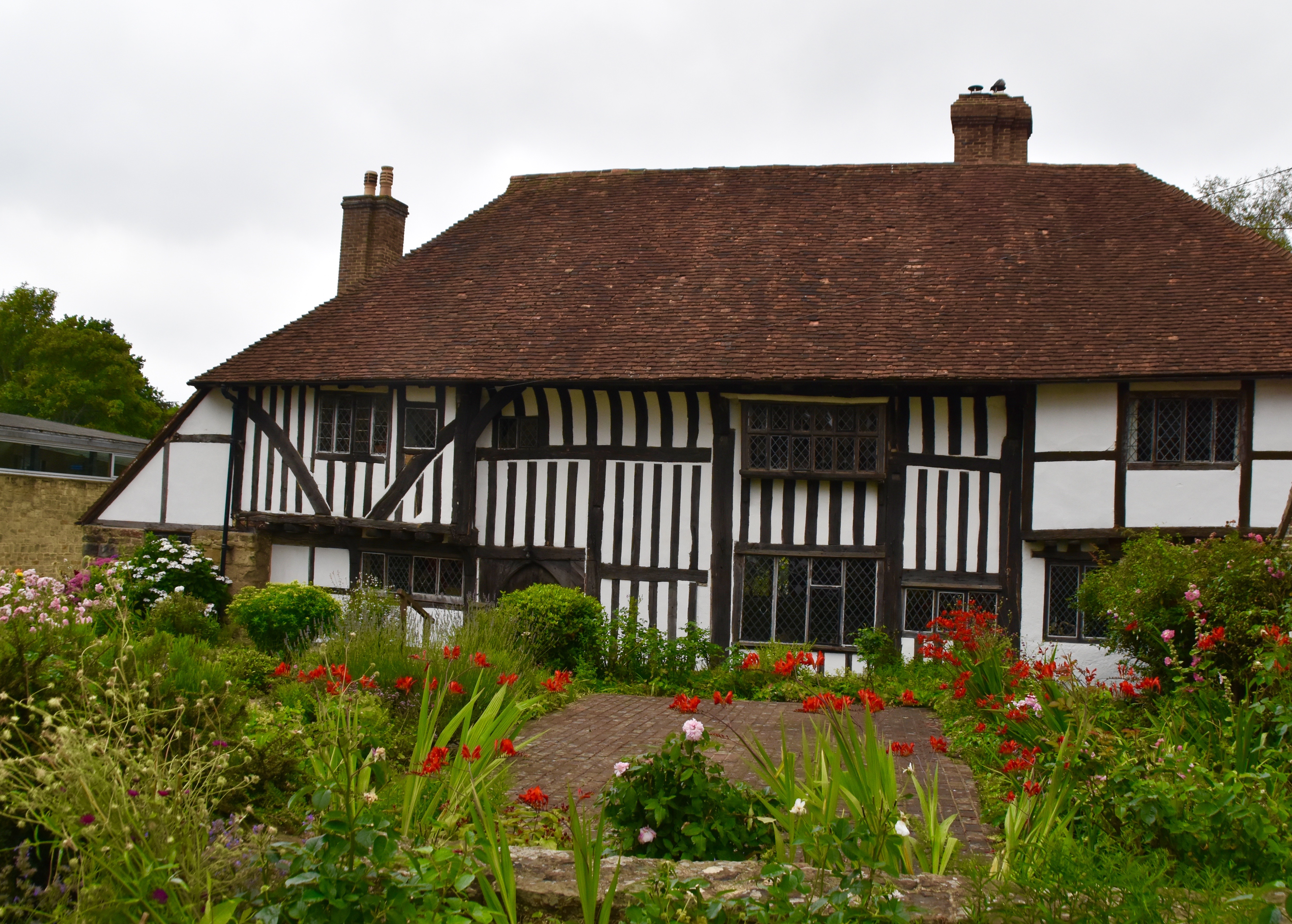
After lunch it was back on the bus for an enjoyable ride through a portion of South Downs National Park, passing the resort city of Brighton and Arundel castle along the way. Just over two hours later we pulled into Portsmouth, one of the most storied cities in England. Birthplace of Charles Dickens and one time home of Arthur Conan Doyle and Rudyard Kipling, this city of just under 250,000 souls is also the home of arguably Britain’s greatest institution, the Royal Navy. The city is actually on an island and has a very protected location with the Isle of Wight lying just offshore, making it virtually impossible for enemy ships to get anywhere the Royal Naval Dockyards before being blasted by batteries on all sides.
The skyline of Portsmouth is dominated by the 170 metre tall Spinnaker Tower which emphasizes the city’s nautical heritage and provides a great vantage point from which to view the city.
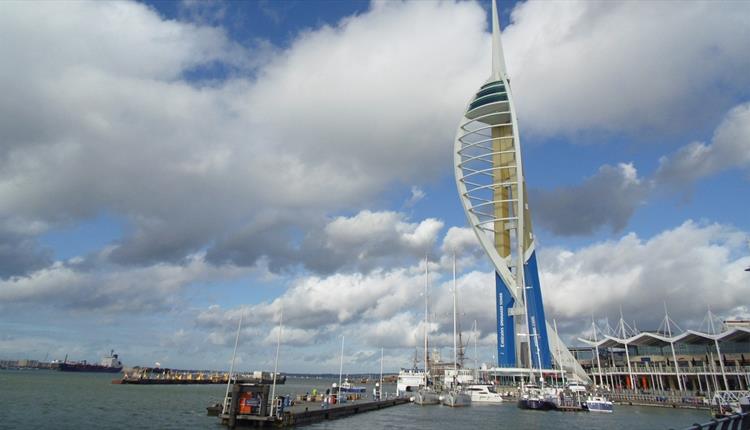
However, we are here to see another tourist attraction, one of the most popular and important in Great Britain, Portsmouth Historic Dockyard which has eleven different attractions associated with the Portsmouth Naval Dockyard. These include the National Museum of the Royal Navy, HMS Warrior and the Submarine Museum, but the real attraction for most visitors is the HMS Victory, the most famous and storied ship in the Royal Navy.
Our Trafalgar tour leader, Mark Gascoigne collects the tickets and Phil leads the way to the HMS Victory passing this figurehead of Admiral Benbow along the way. He was a controversial figure who had two of his captains executed for cowardice in refusing to join him in a fight with the Spanish fleet off Colombia, but was immensely popular with the British public who followed the exploits of their great sea lords with alacrity. I mention this because from the moment you enter Portsmouth Naval Yards you are immersed in the history of Britain.
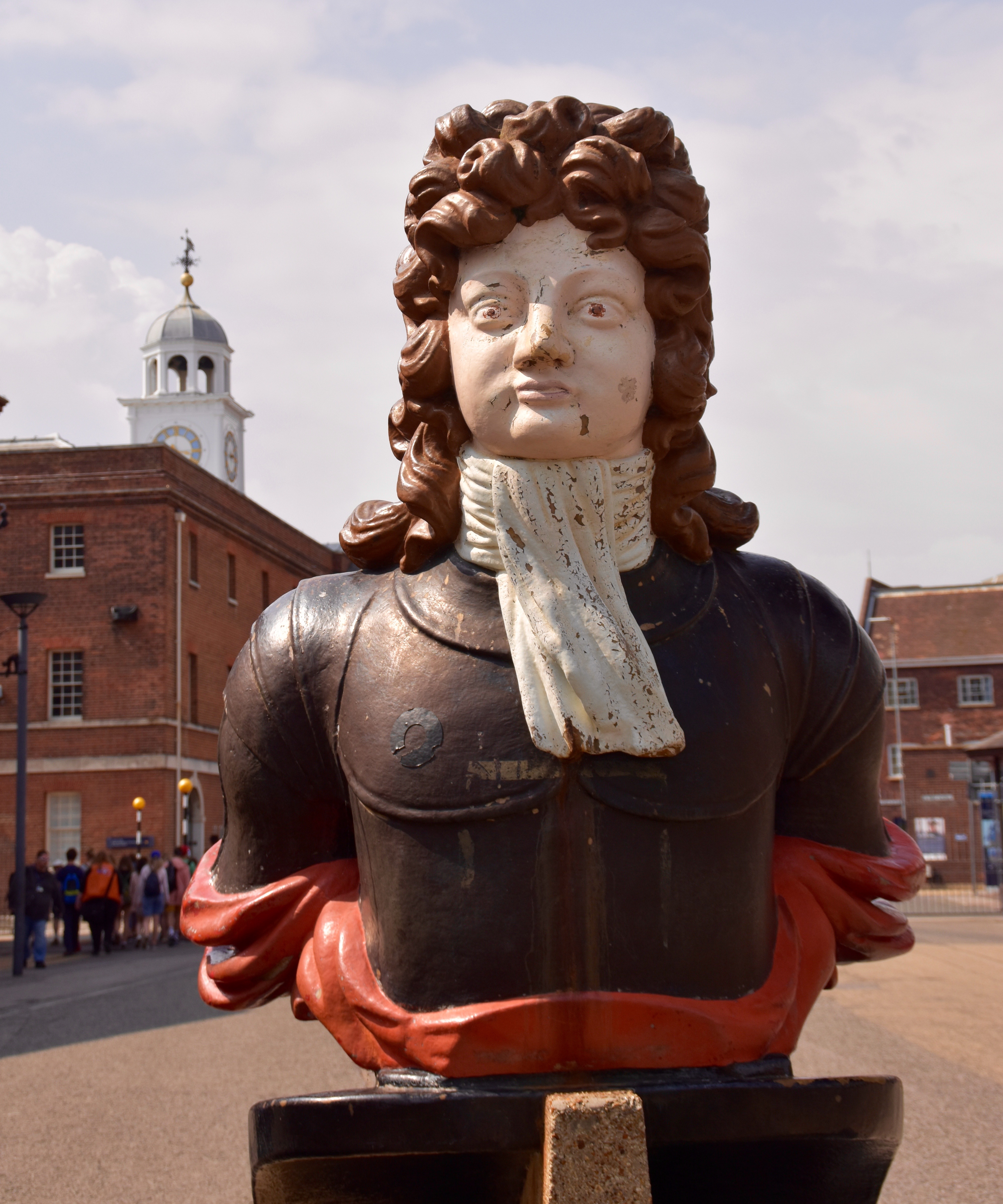
BTW the opening scene of Treasure Island takes place in the Admiral Benbow Inn.
One could easily spend the entire day exploring Portsmouth Historic Dockyard. Here is the British Navy Museum which is huge.
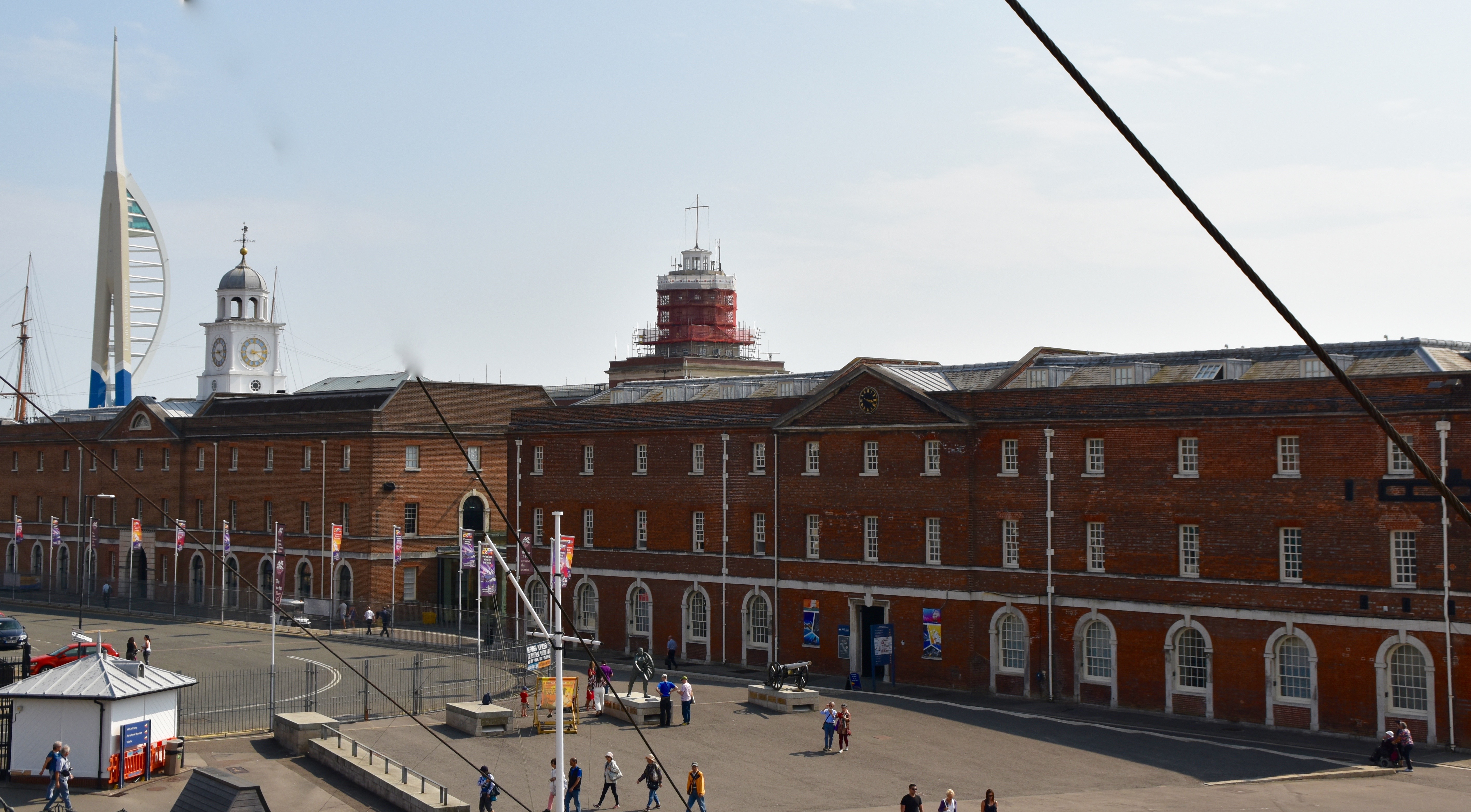
However, our time is limited so Phil leads us to the most important artifact on display, the HMS Victory. Actually artifact is a completely misleading word because HMS Victory is still a commissioned ship and is officially Flagship of the First Sea Lord.
Touring HMS Victory
Over my many decades of visiting wonders around the world, I am often surprised at how small some things are compared to how large one imagined them to be – Mount Rushmore is a good example. This phenomenon seems to be particularly true of ships. Only a few days ago Alison and I came across a replica of Drake’s Golden Hind that is being built on the south embankment and once again I was amazed that a ship this small had actually circumnavigated the globe, the second to ever accomplish that feat.
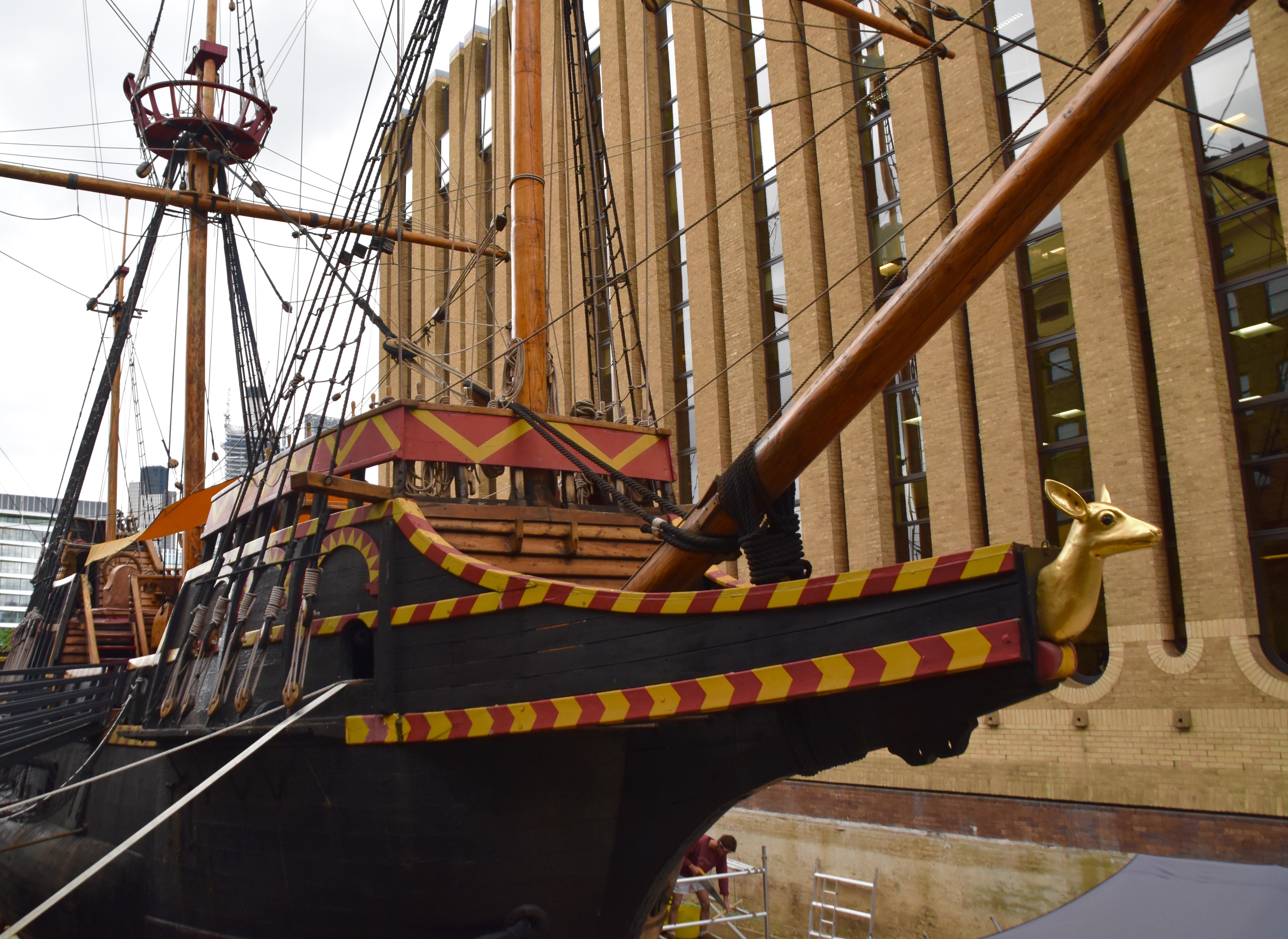
Well, I can write without fear of contradiction, that this will not happen the first time you lay eyes on HMS Victory – it is simply stunning in both size and presence. Absolutely bristling with cannon and painted in the distinct pattern Nelson ordered so the British could separate friend from foe on the open waters, this is a ship of the line in every sense of the word. I think it is magnificent and it has the battle honours to back up its fearsome appearance.
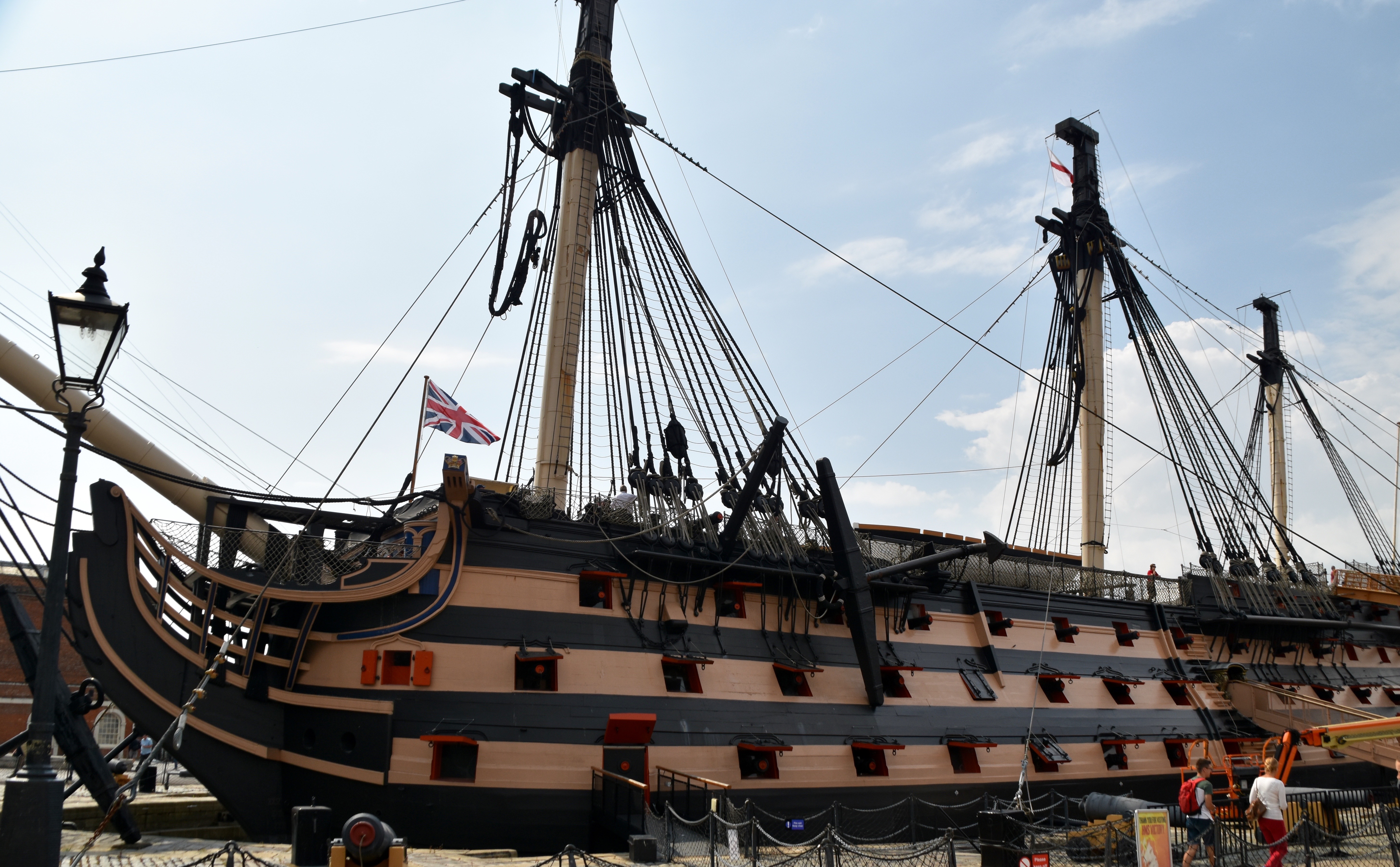
There is a large open area in front of HMS Victory with allows one to get a perspective on the ship from most angles. Phil takes advantage of this space to give us a history lesson on Admiral Horatio Nelson, the Battle of Trafalgar and Nelson’s controversial relationship with Lady Hamilton. I won’t repeat it here other than to briefly say that three topics Phil touched upon have one theme in common – greatness. Nelson was without doubt the greatest of British Admirals, the Battle of Trafalgar without doubt the greatest naval victory of the British Navy and the affair between Nelson and Hamilton the most scandalous in British history.
Phil ends his presentation quoting Nelson’s famous admonition to his captains on the eve of the Battle of Trafalgar, “England expects that every man will do his duty” and we line up for a group photo before entering HMS Victory.
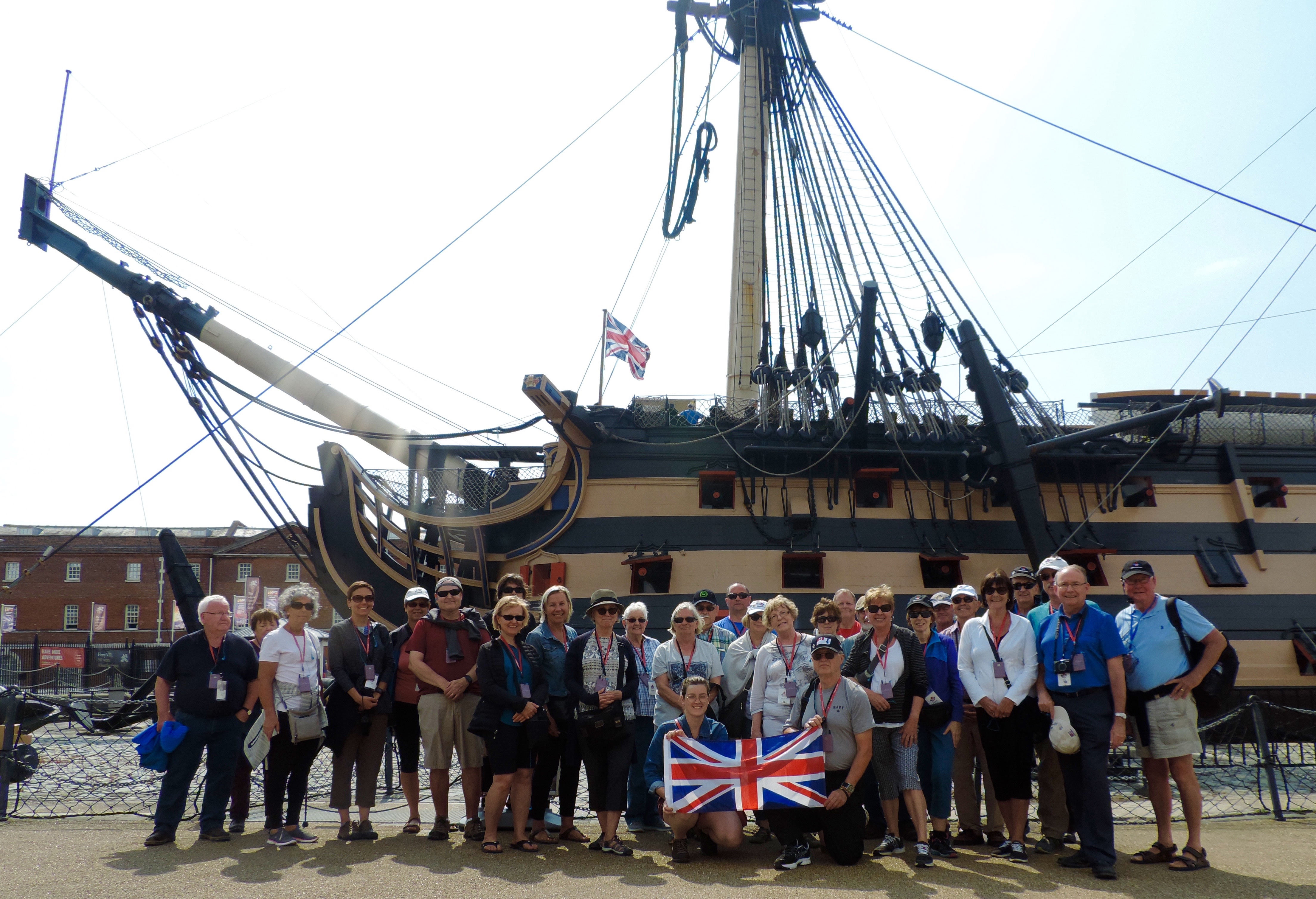
Visitors to HMS Victory follow a designated route that starts on the main deck and winds its way down deck after deck until you think you must be on the ocean floor. The ladders or steps between decks are steep and persons with mobility issues may have difficulty. As well, expect to bang your head at least once and probably more. Wear a hat to diminish the blows. Visitors are provided with what I would call an audio wand. You point it at a designated spot on HMS Victory and get a detailed description of a room, person or event.
As you step aboard HMS Victory you pass under this wooden crown.
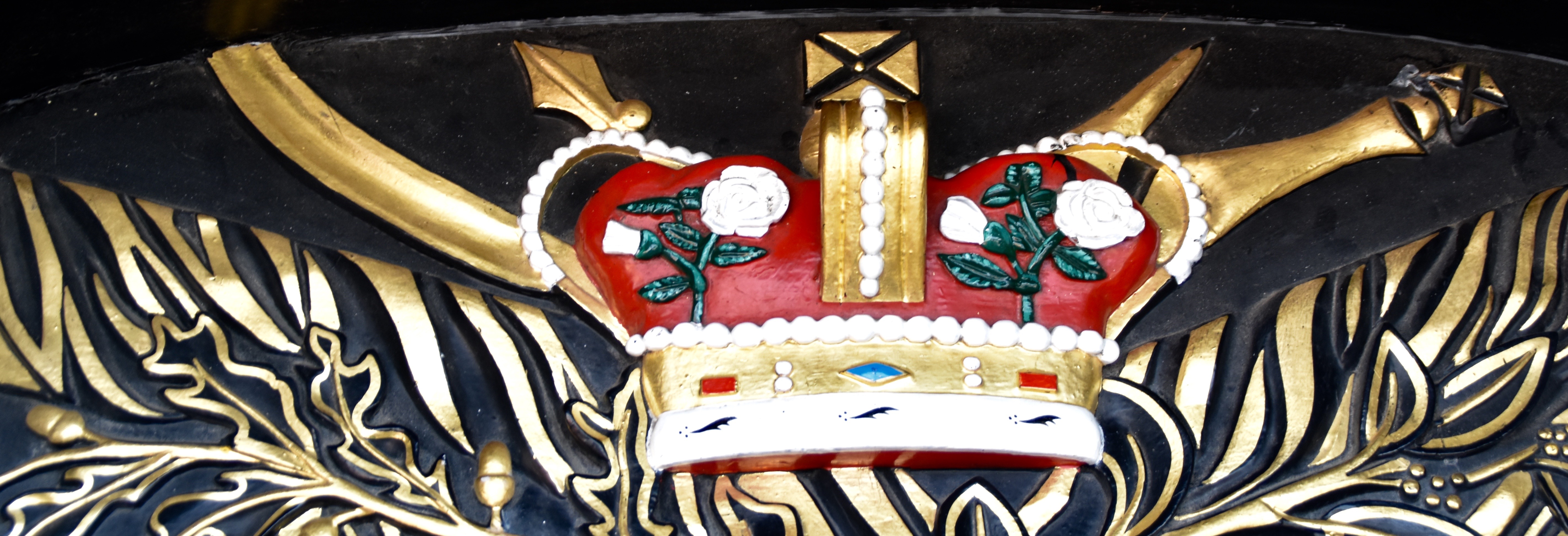
This is the view from the highest point on the ship that tourists are allowed upon, the poop deck.
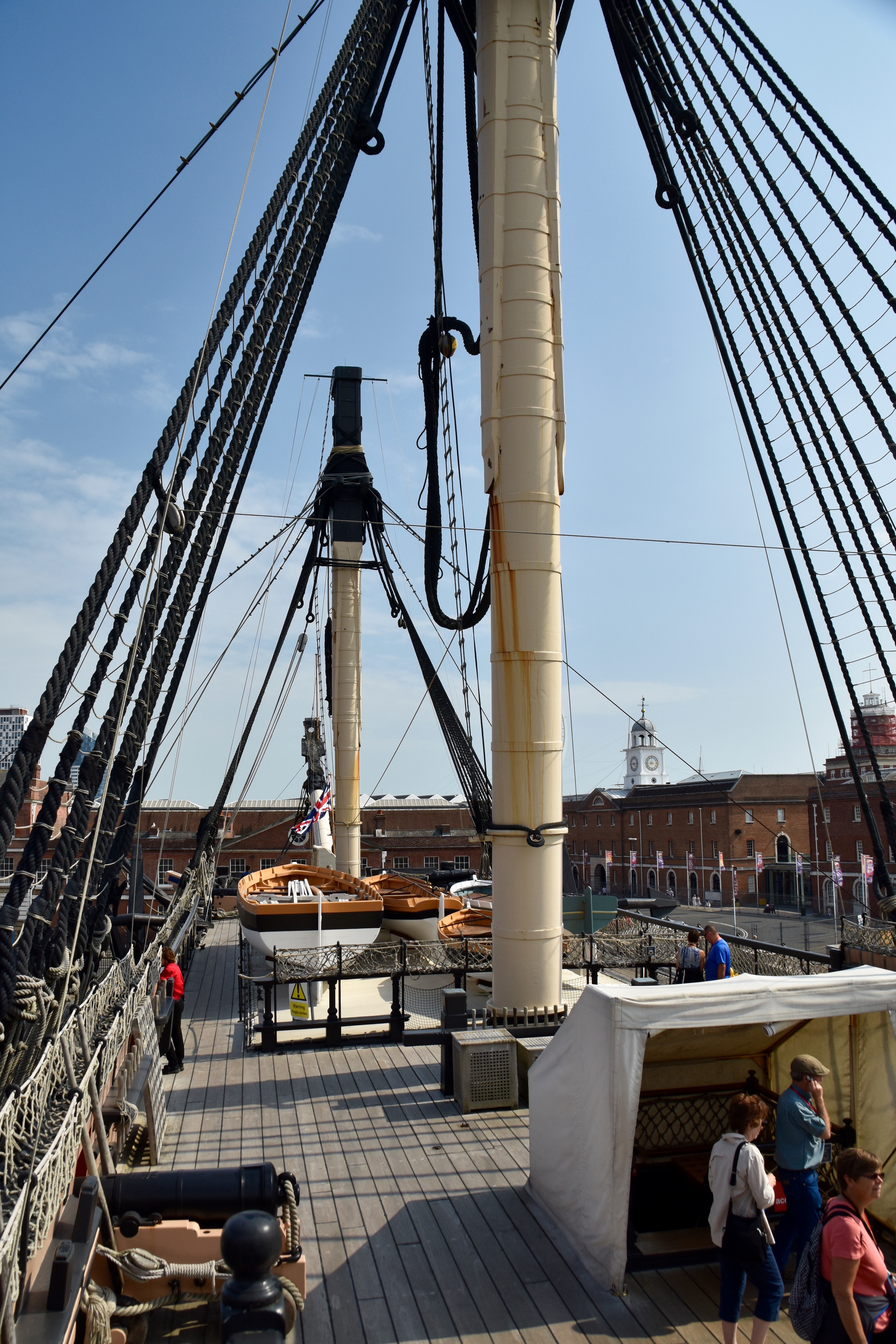
From an historical perspective, the most important spot on the main deck is the one commemorated by this brass plaque. Here Nelson was felled by musket ball, possibly a deliberate shot by a French or Spanish sniper as Nelson refused to take cover during the battle.
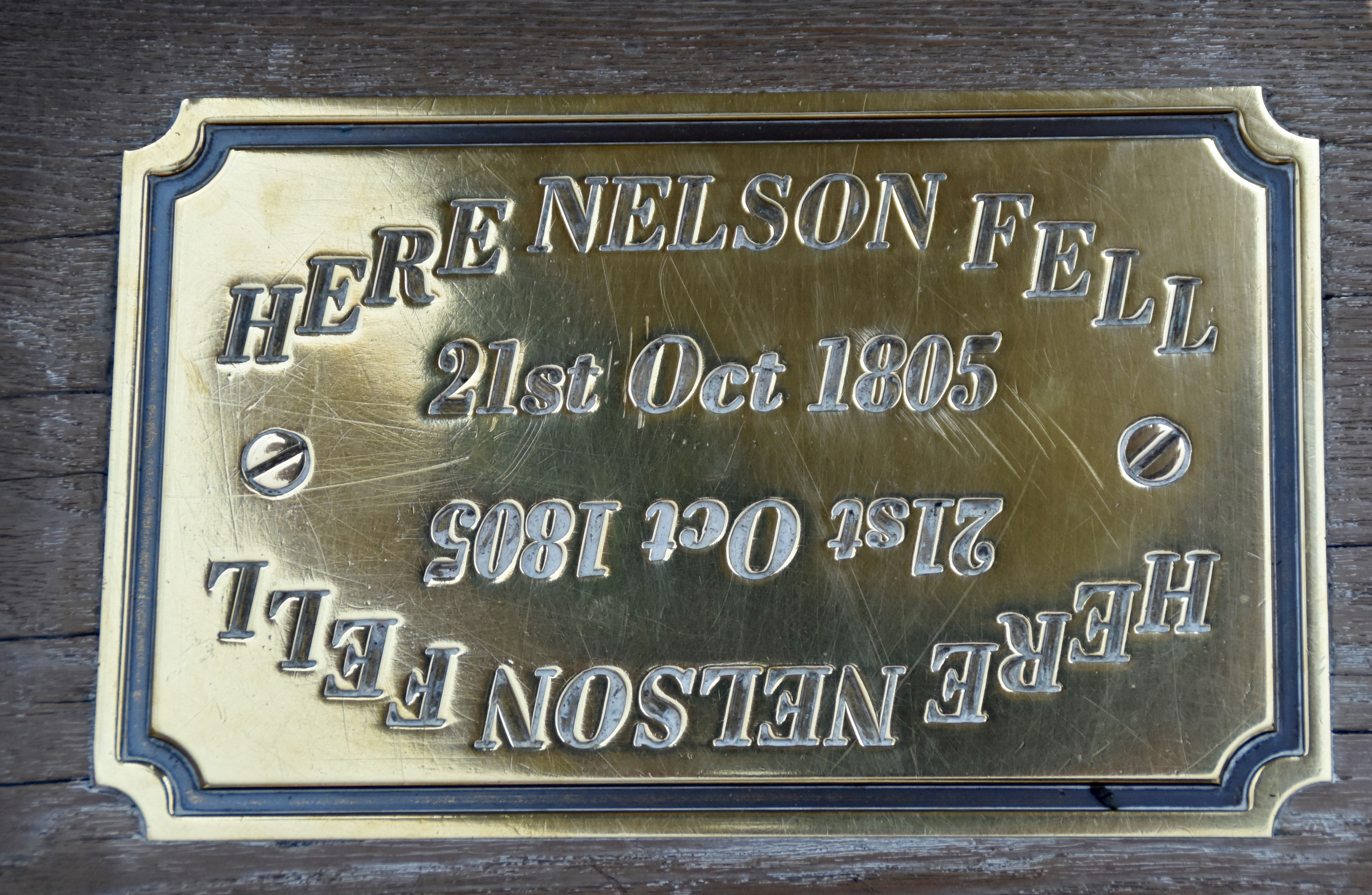
One thing all visitors should do is take the wheel of HMS Victory and pretend you are steering her through the enemy ships on both sides to deliver the resounding cannonades into the bow and stern that crippled the French flagship Bucentaure and left the enemy leaderless.
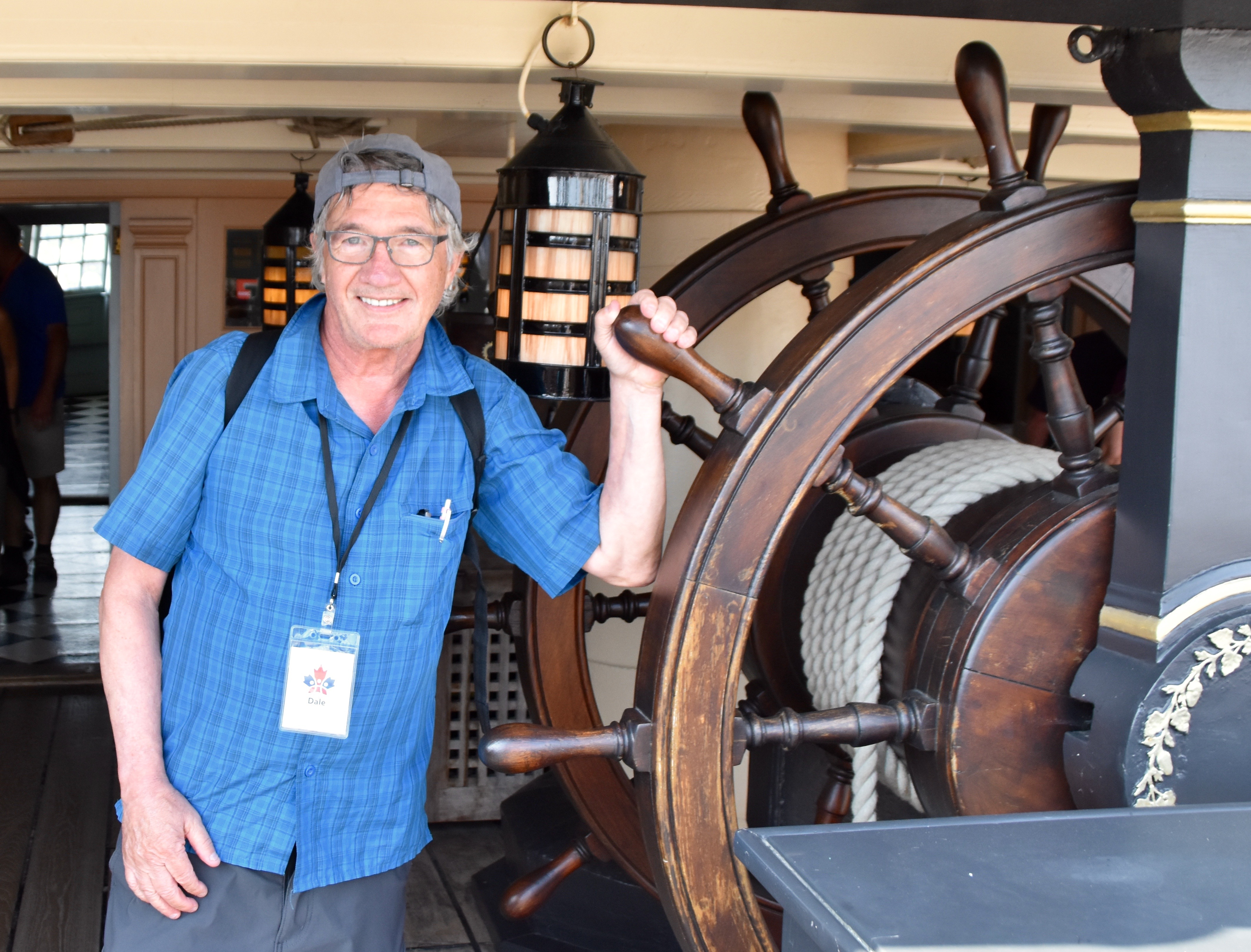
Life aboard HMS Victory was very much divided along class lines with the Captains and officers actually living quite luxuriously. This is Captain Hardy’s dining room. Many people mistakenly think that Nelson was Captain of HMS Victory. He was in fact Admiral in charge of the entire British fleet. Each ship had its own captain, in the case of HMS Victory Captain Thomas Hardy who fought in almost every major naval battle of the Napoleonic Wars and went on to become Vice-Admiral himself.
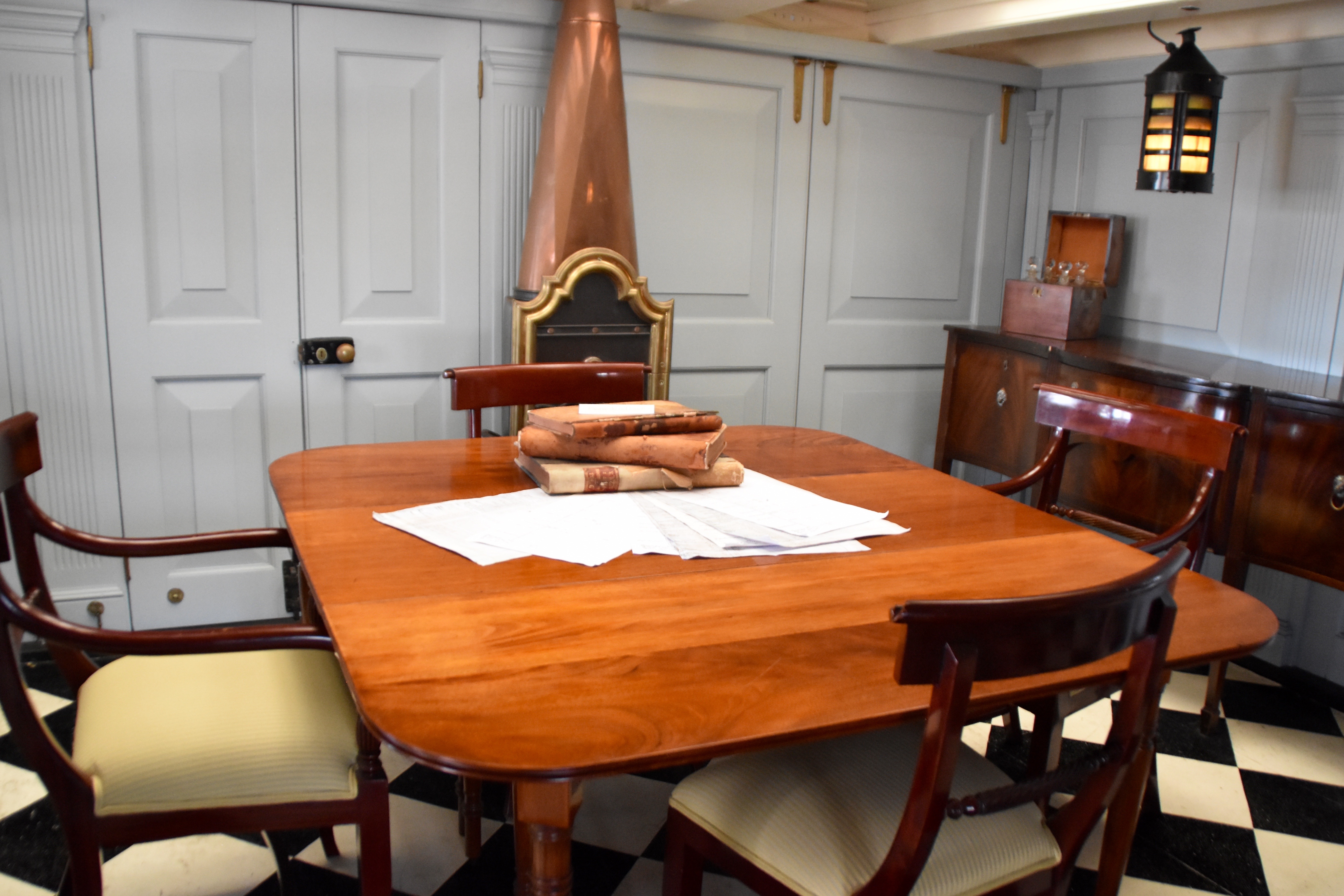
As you can see the officer’s lived in relative comfort aboard HMS Victory with Nelson even having a proper bed. The more junior officers slept on swinging bunks like these.
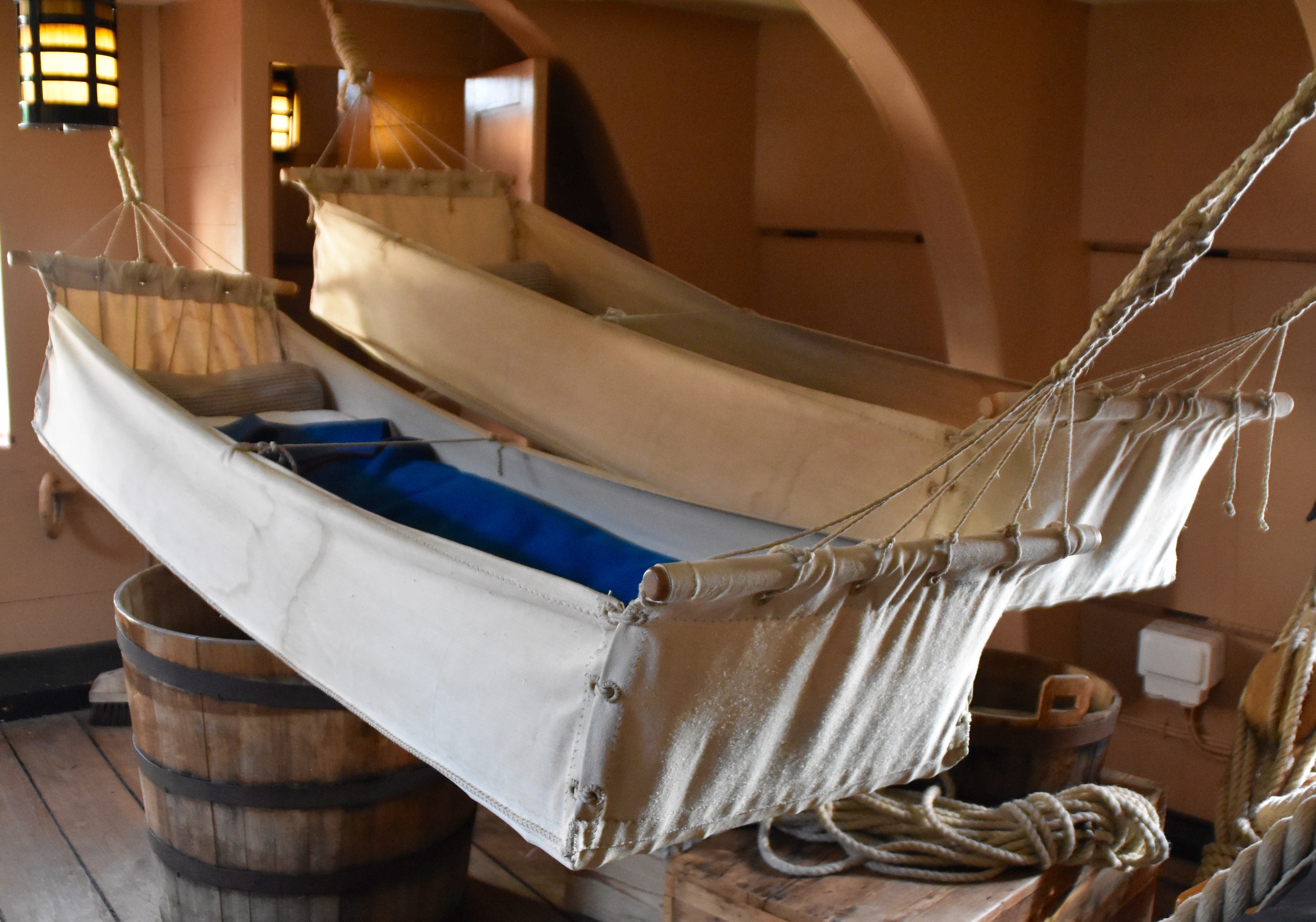
While the ordinary seamen had these hammocks; imagine how these would sway in a heavy sea. Rock a bye baby to the nth degree.
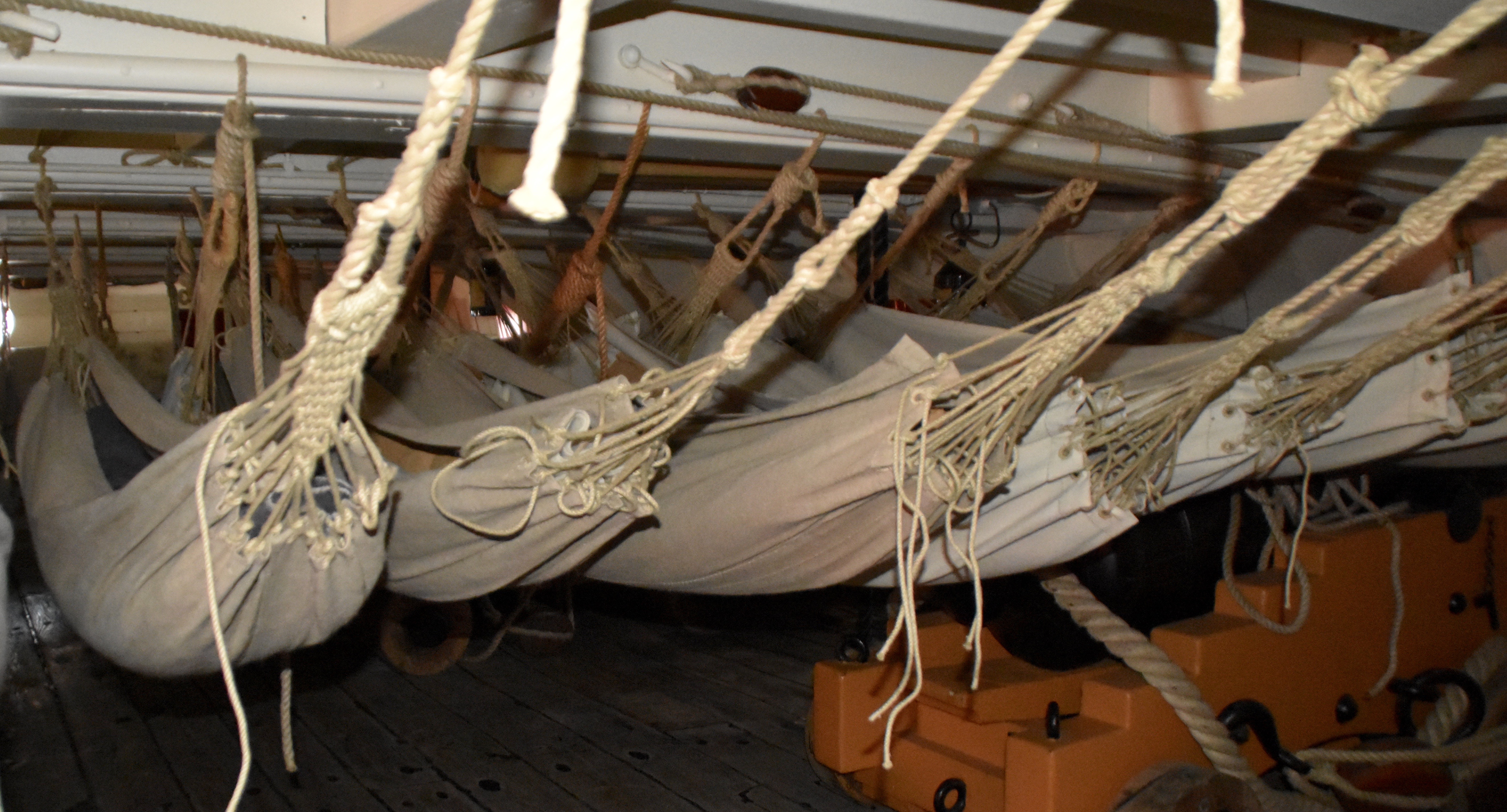
Here is a photo of the real reason why Britannia ruled the waves and was able to hold on to a vast empire for 200 years. Put simply, no one could out gun the British navy.
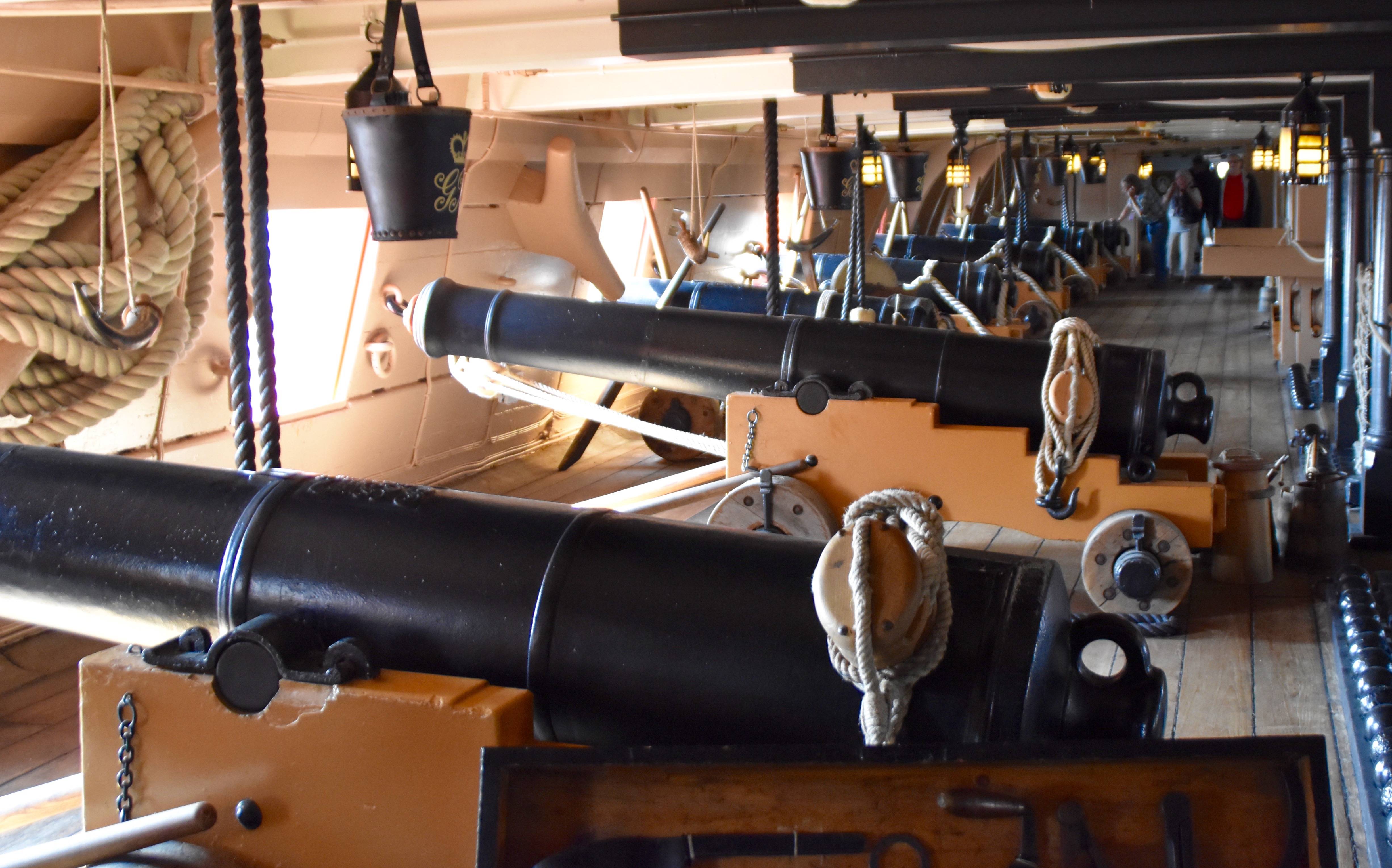
If you’ve ever read any of the Captain Jack Aubrey novels by Patrick O’Brian you’ll know that British sea captains, or at least the good ones, were obsessed with the speed with which their crews could fire their guns. Constant practice along with a sense of pride and teamwork were the hallmark of a ship like HMS Victory. During the Battle of Trafalgar the crews managed a rate of fire of every ninety seconds, far superior to the French and Spanish gunners. It was the ordinary British seaman, recruited or pressed from the lowest ranks of British society, who provided the blood, sweat and tears that allowed Britain to win naval engagements against opponents who had more guns, bigger ships and more men. Nowhere on HMS Victory did I feel closer to understanding British sea power than below decks with these cannons.
After exiting HMS Victory we walked across the open area to get our picture taken with this absolutely fabulous figurehead from HMS Trafalgar, one of five ships named for that sea battle. Here is the epitome of British seamanship – Nelson with one eye and one arm lost in previous engagements, giving his all for the cause of his country.
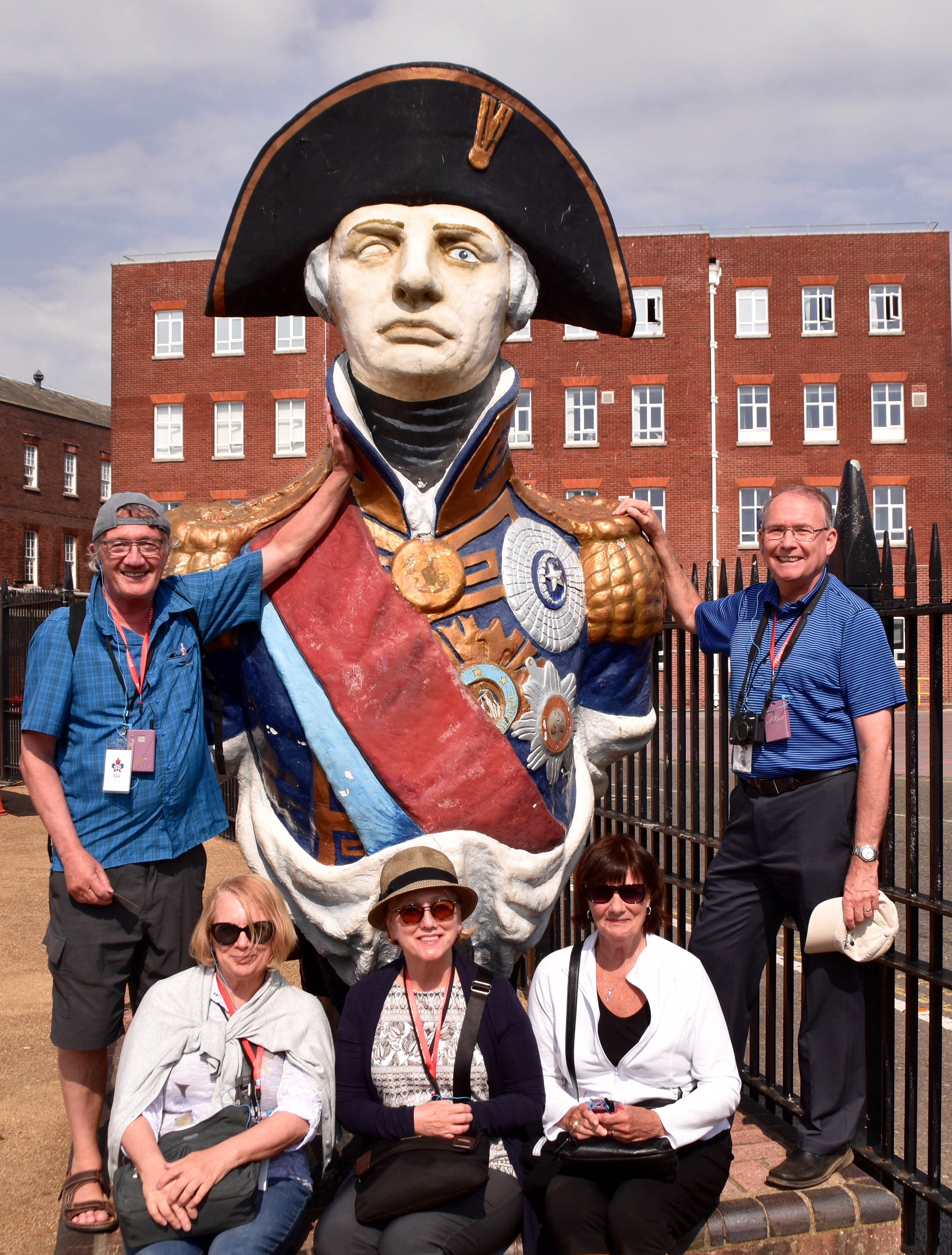
Our stay in Portsmouth was at the Queen’s Hotel, a stately looking, if somewhat faded Victorian era relict with views of The Solent and the Isle of Wight.
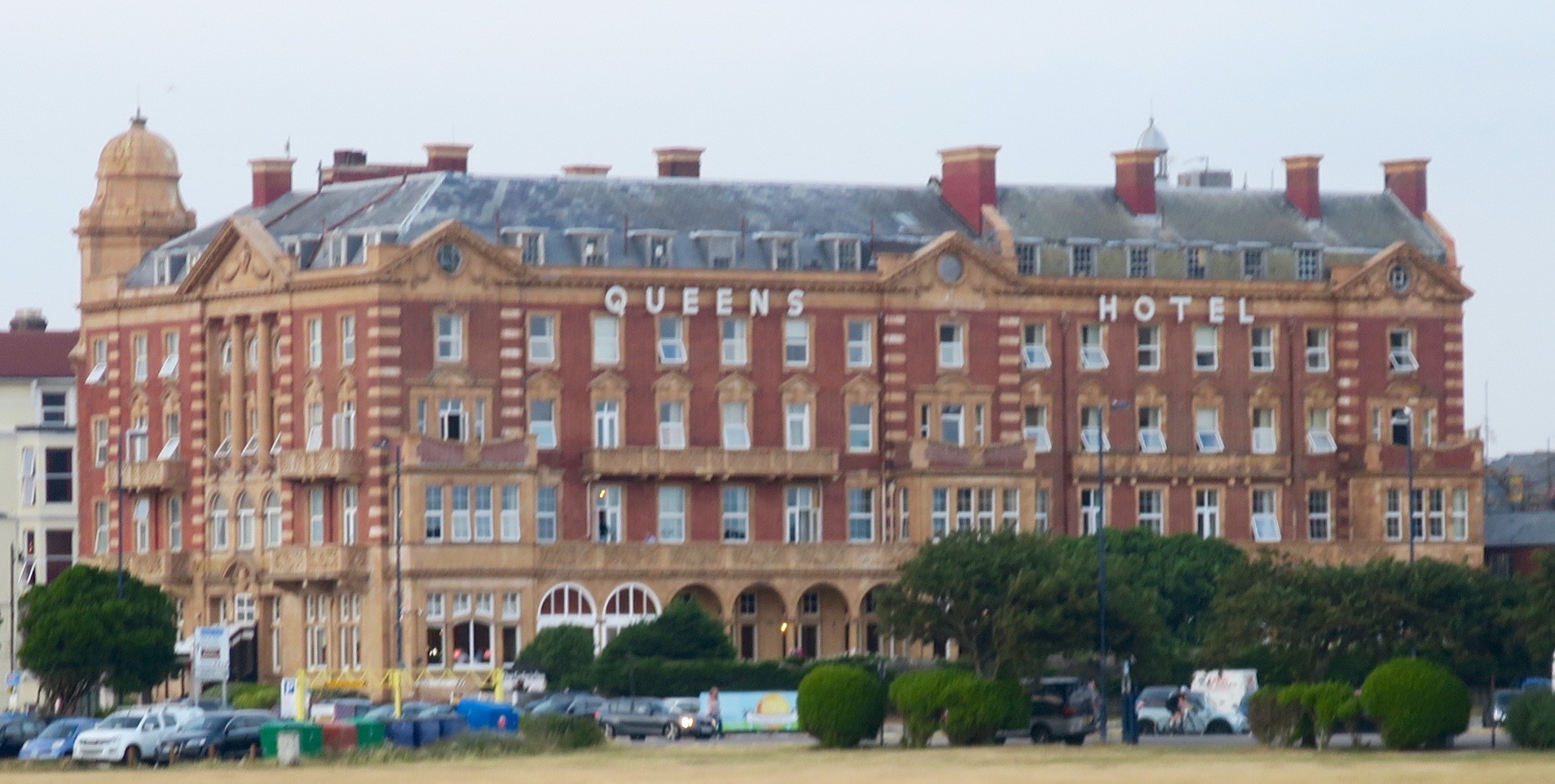
Portsmouth Naval Memorial which is nearby is a must visit if you are on this tour. The thousands and thousands of names of British seamen who died in both world wars is very moving, particularly that portion of the memorial dedicated to the men lost at sea with no known graves. This is their only remembrance.
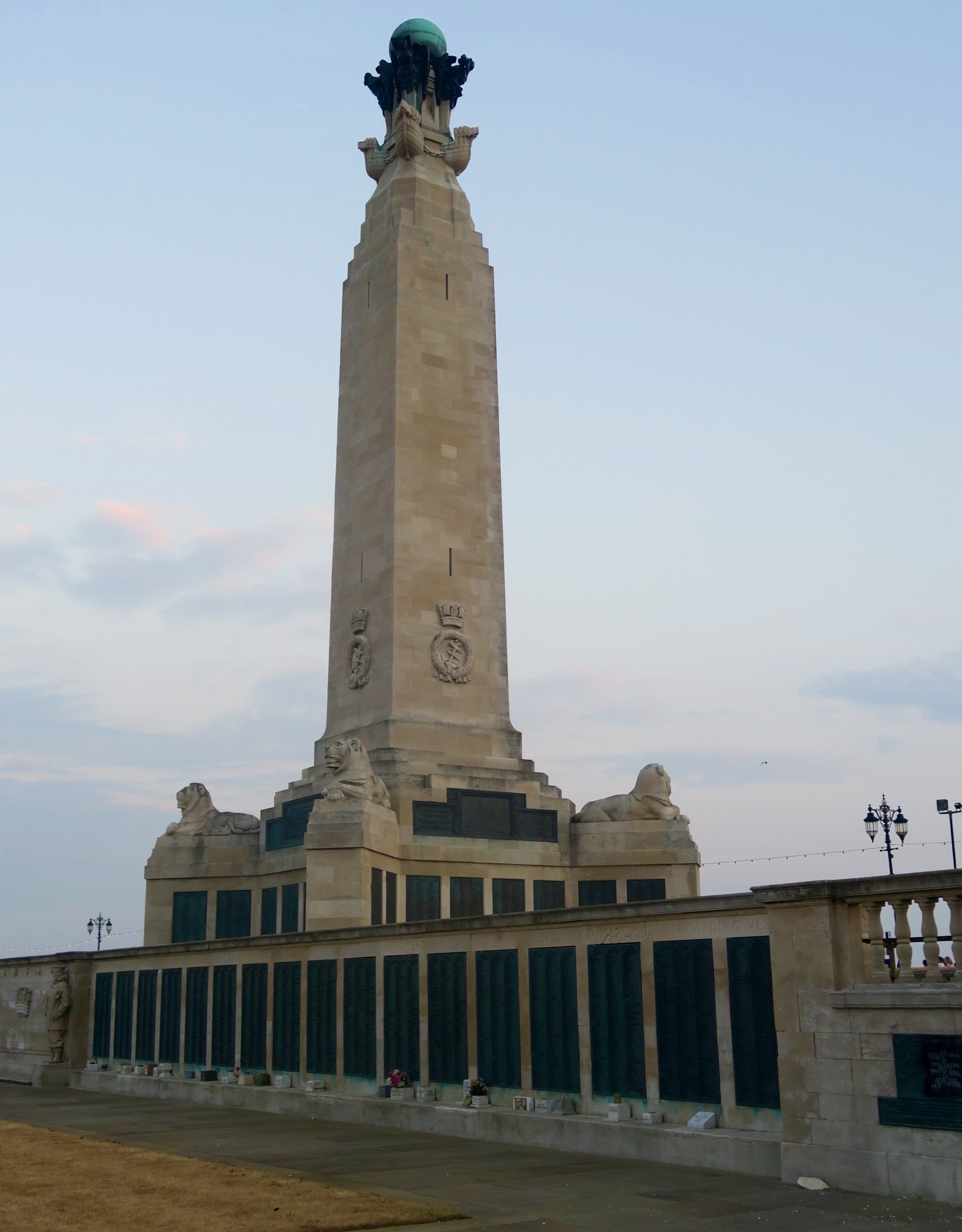
The Queen’s Hotel is next to Osborne Road which has a slew of restaurants including one I highly recommend to anyone who might follow us on the next Medieval Britain tour.
Algarve’s Grill is run by a couple of young enthusiastic Portuguese guys who offer both traditional Portuguese dishes which Alison and I loved, as well as American bbq ribs and chicken for the less adventuresome.
This is Carne de Porco à Alentejana, a great combination of pork, clams and olives.

Here is their version of garlic shrimp.
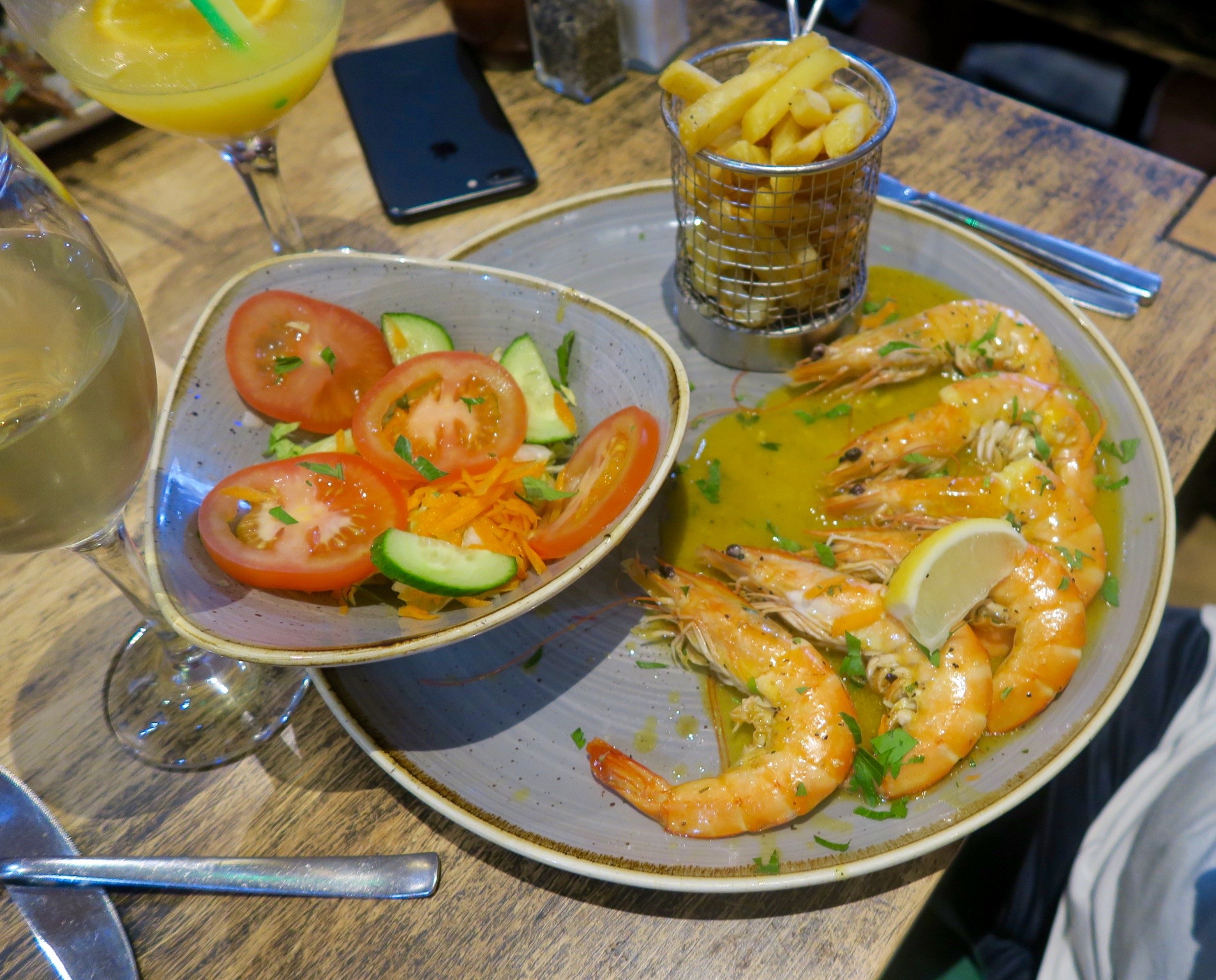
Washed down with a bottle of brilliantly dry and minerally EA Blanco Portuguese wine, you’ve got yourself a perfect meal.
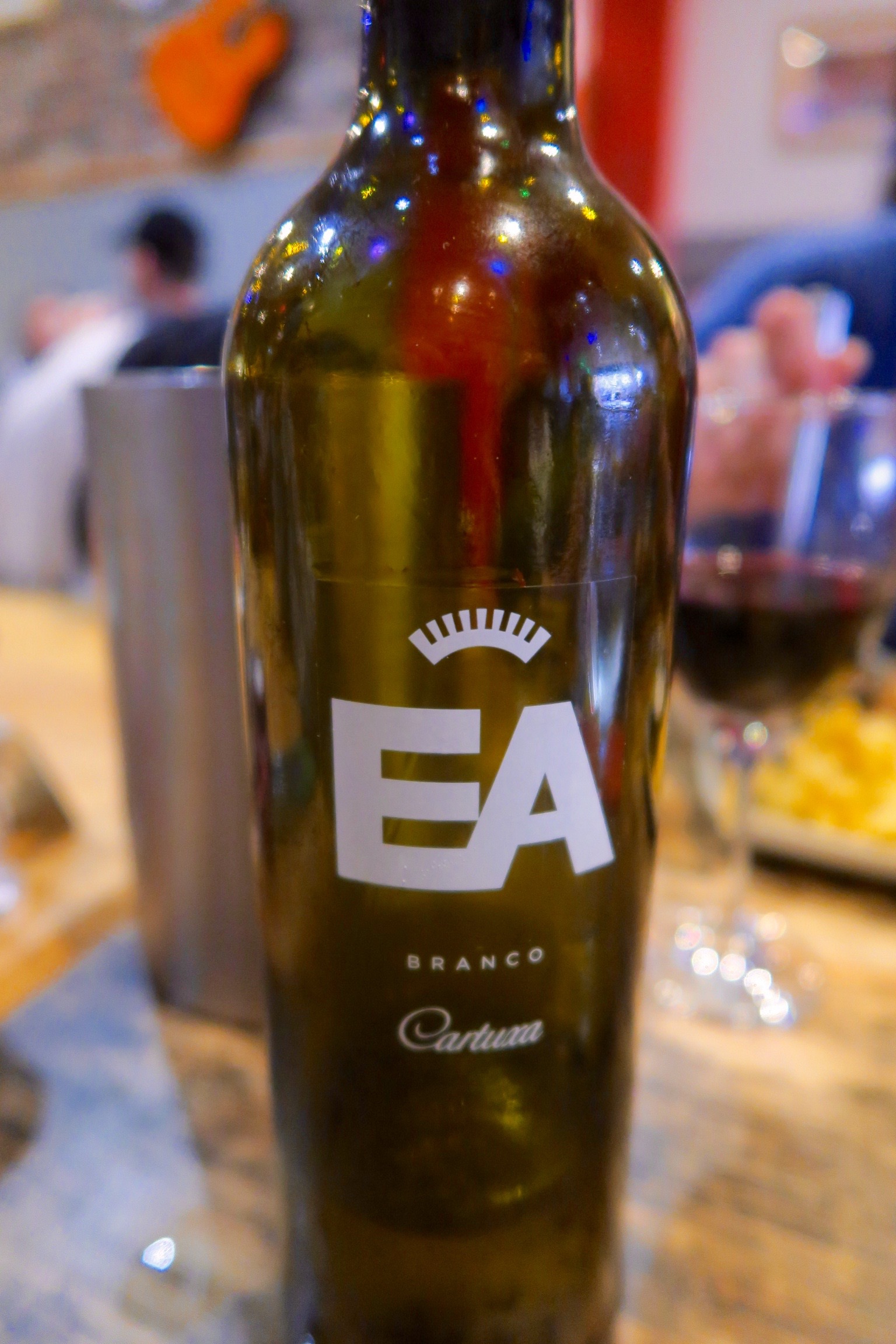
And so ends the first full day of Liberation Tours Medieval Briatain and what a day it was, from the Battle of Hastings to the Battle of Trafalgar. If the rest of the trip lives up to today’s standard it will be one for the ages.

